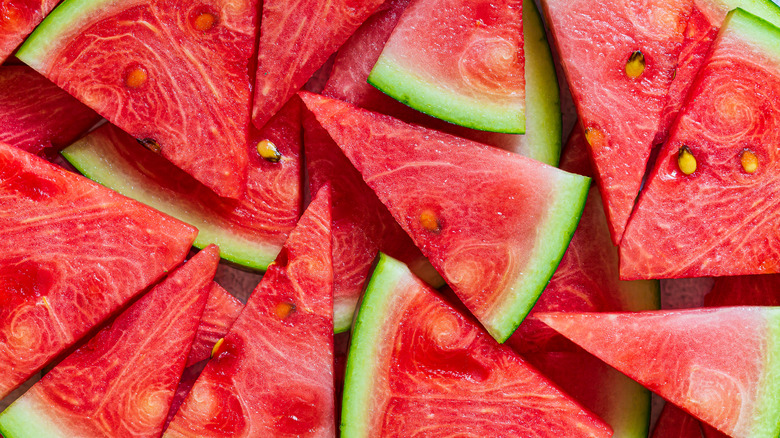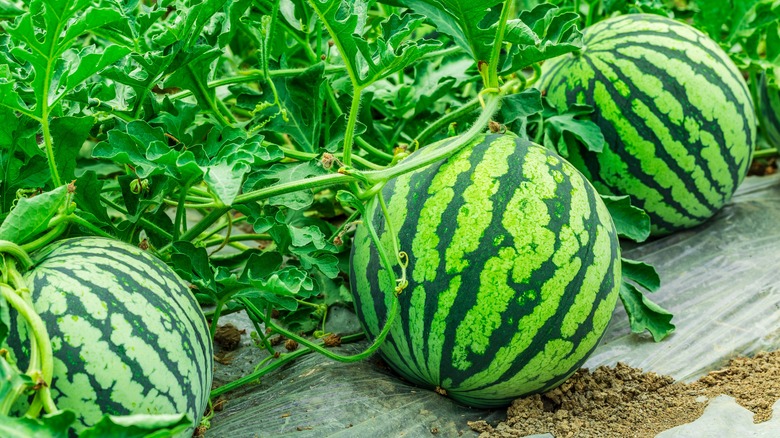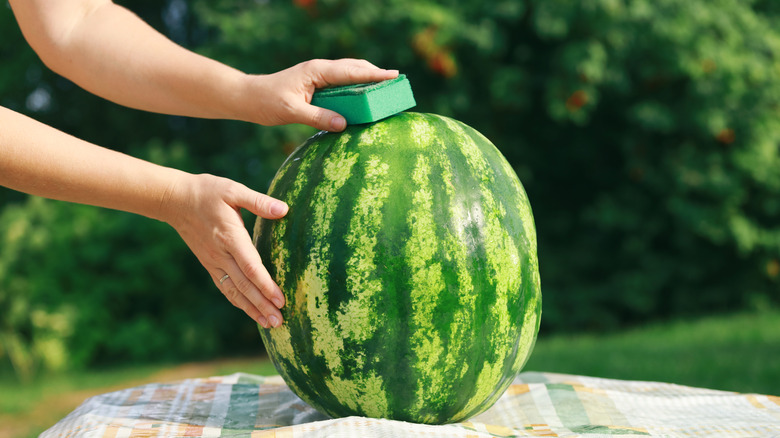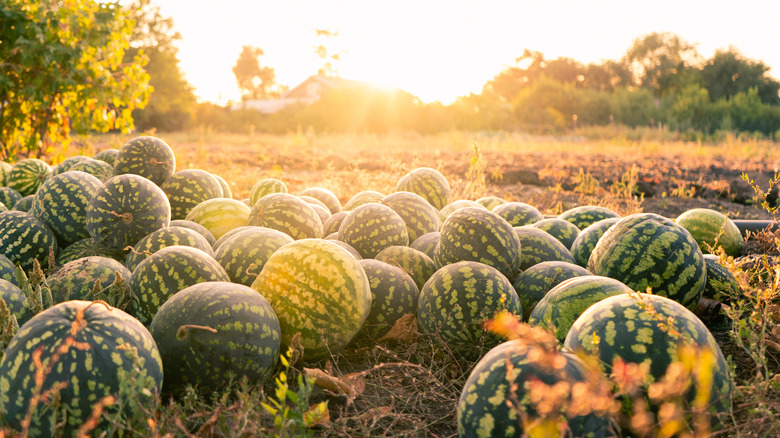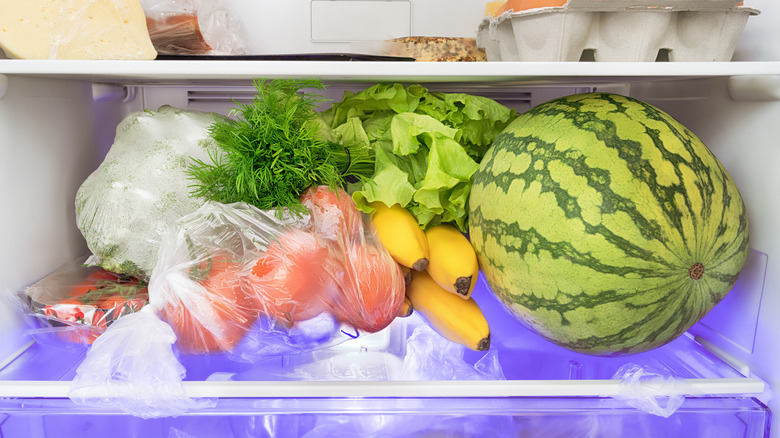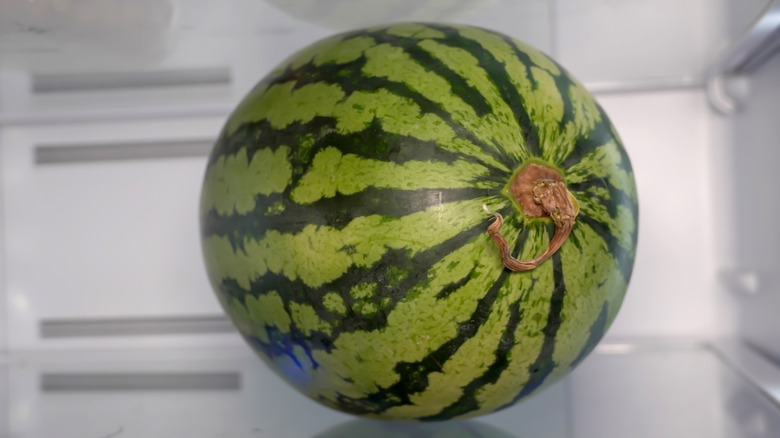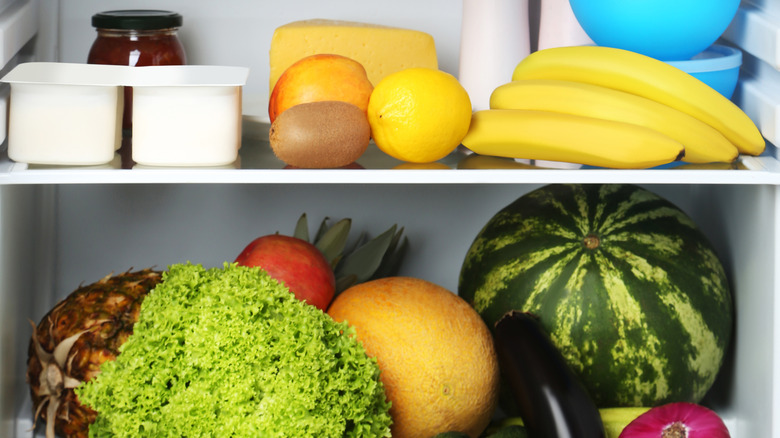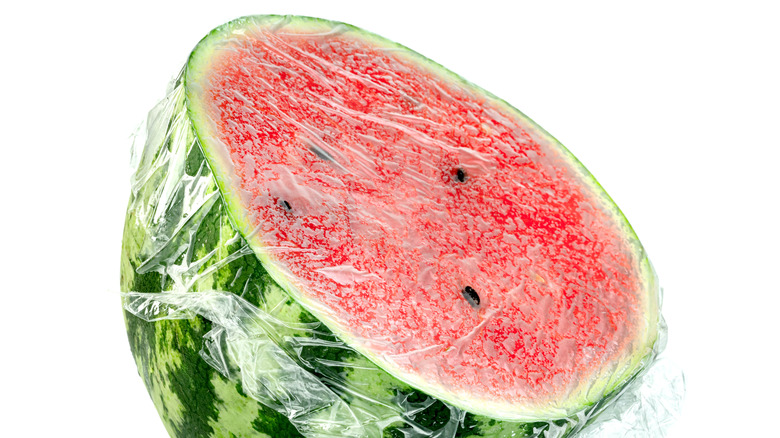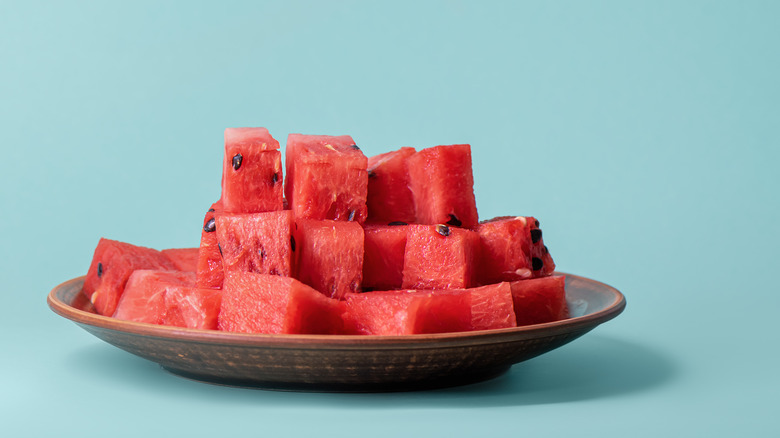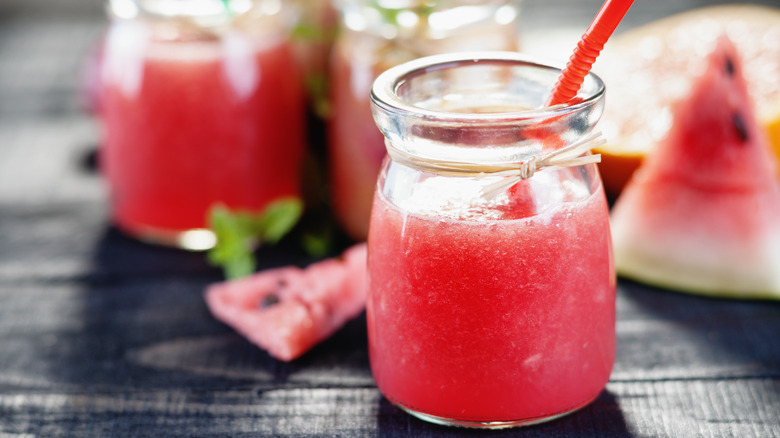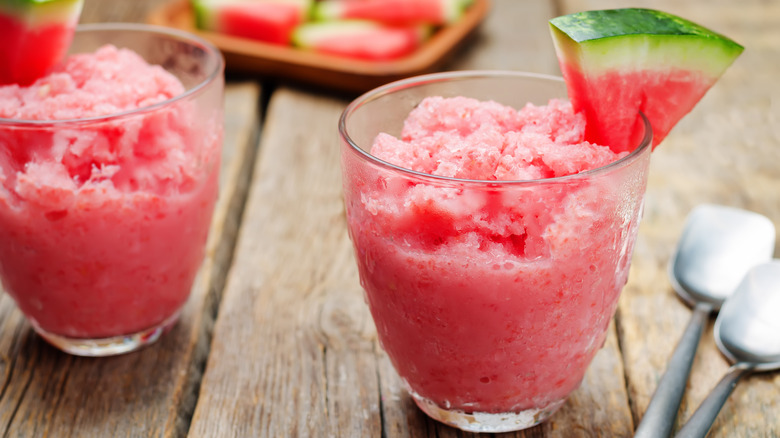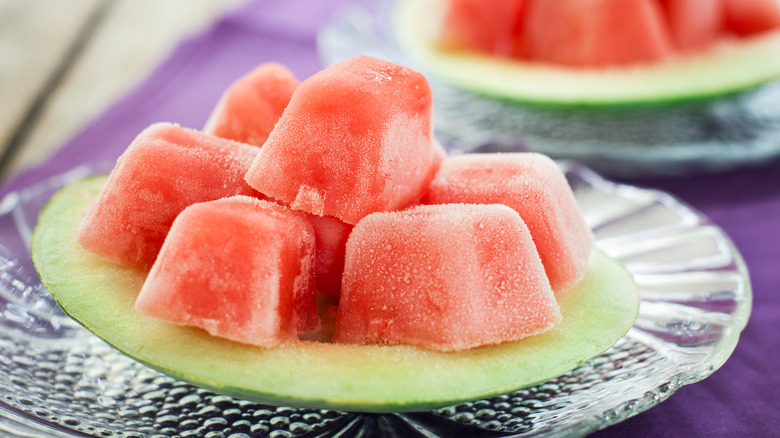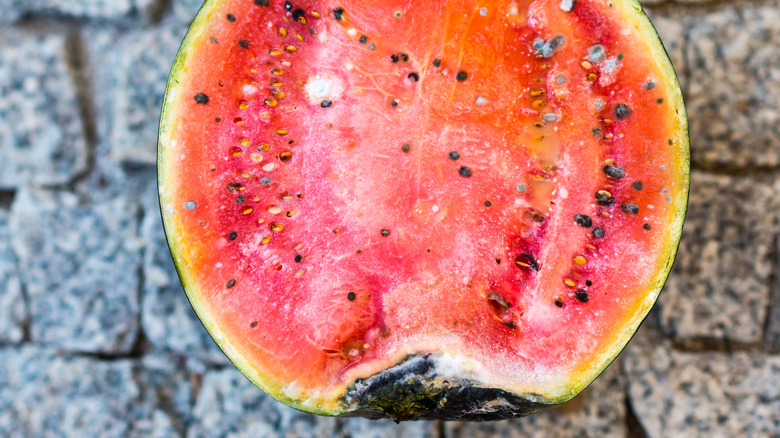14 Storage Tips For Longer-Lasting Watermelon
We may receive a commission on purchases made from links.
Watermelon is a true classic. This is true whether you eat it with salt (which some say is the one secret ingredient you need to sweeten watermelon) or plain. It's true whether you eat it with other fruits or in an arugula salad with feta. And it's true whether you prefer yellow watermelon or red. Flat out, straight up, pretty much everybody loves this juicy fruit.
Folks especially appreciate watermelon during the summer, when temperatures soar in the daytime and remain warm at night. It's the perfect time of year for a refreshing slice ... which is why it's so disappointing to pull out said melon and discover it's gone off. Luckily, to avoid that fate, there are plenty of steps you can take.
This starts with understanding how to choose your melon, and then knowing where and how to keep it stored until you're ready to eat it. Once you cut into the melon, a whole new slough of tips apply if you don't plan to devour it in one go. And, of course, you should know how to identify when it's gone bad. Here are 14 storage tips that will help you keep your watermelon good for days (or even weeks) to come.
1. Choose a watermelon according to your needs
No matter how you plan on eating your watermelon, its longevity starts with selecting the right one. Choosing the best watermelon is different than, say, choosing the best cantaloupe, honeydew, or other types of vine-ripened melons. Every melon has its own tips and tricks, so don't try to apply one approach to another kind.
For watermelon specifically, look for weightiness. Compare several melons and choose the heaviest one, which indicates the most juice and sweetness. Also, look at the discolored spot where the melon rested on the ground. It should be light yellow or cream-colored, not white (underripe) or dark yellow (overripe). Then give it a sharp tap with your hand and listen for a hollow sound.
Note that farmers may harvest melons at the peak of ripeness, as they often do when selling them locally at stores, farmer's markets, farm stands, or u-pick lots. However, for those that must travel longer distances, they often harvest them a bit prematurely, known as the "half-slip" stage. This allows them to withstand longer travel times. If you need to lug your watermelon a ways, such as on a camping trip, choose a less ripe one that won't get mushy. If you're going to eat it quickly, use the telltale signs above to pick the ripest one of the bunch.
2. Wash your watermelon
The good news is, watermelon has a smooth rind and not a pitted surface, the latter of which is more likely to harbor dirt and pathogens. The bad news is, those can still live on the surface of watermelon, so you should always remove them by washing the melon as soon as you get it home. That way, you avoid transferring microorganisms from the surface onto the clean fruit with your cutting knife.
The easiest way to wash a melon is to put it right in the sink and run cool water over it. The U.S. Food and Drug Administration (FDA) does not recommend using soap or a produce wash, instead instructing cooks to simply scrub the watermelon with a produce brush if necessary. Other sources say you can use vinegar to clean it. To do so, fill the sink with cool water and add ½ cup of 5% distilled white vinegar for every 20 cups of water. You will probably have to rotate the melon while scrubbing it, as otherwise it will float and bob.
3. Store it at room temperature
Whenever possible, you want to serve watermelon at room temperature. While cold watermelon is yummy, cooling reduces the amount of lycopene (responsible for that bright red color) in it. That's a shame, since lycopene is a powerful antioxidant that can help you fight free radicals and prevent disease, and we want to keep it around. The refrigerator can also affect the flavor and texture of watermelon, making the flesh more grainy and the juice more runny.
The fridge can even hasten the demise of your melon, reducing its shelf life from two to three weeks to only one week. If you can, keep the melon at room temperature for as long as possible. Don't worry, though, you won't harm your watermelon by chilling it for several hours before eating it. This isn't a long enough period to cause any changes to its structure. Just take it out once it's cold and serve.
4. Avoid sunlight
For the same reason that we use gallery glass to preserve art and keep spices in a dark cabinet, you should keep watermelon out of the sunlight. While the sun is a great sweetener and ripening agent in the field, it doesn't help lengthen storage time once you get the melon home. Why not? Interesting question.
The sun's rays are antimicrobial and are being studied as part of an effort to reduce foodborne illness in produce. That said, sunlight can also speed up the breakdown of matter, according to a study published in Oecologia. This process is known as "photodegradation." If that kind of sounds like the opposite of photosynthesis, that's because it kind of is. Heat will make watermelon flesh dry and fibrous as well as potentially reducing its shelf life.
To avoid this happening to your melon, choose a dark storage location if you can. Cupboards and countertop corners are ideal. If you don't have a dark spot, a countertop with ambient light is fine. It's really direct sunlight you need to watch out for.
5. Pop it in the fridge once it begins to get old
Watermelon doesn't actually ripen on the counter, because it stops ripening as soon as you pick it. However, that doesn't mean it won't continue to get softer, which is just a nicer way of saying mushy. However, you can slow down this process by putting the melon in the fridge, which can extend its shelf life by two to three weeks beyond the time you've already had it. Just note that its flavor and texture will degrade somewhat, even if it doesn't go bad.
If you aren't sure when to put your melon in the fridge, then use the guideline of seven to 10 days as your max. Don't cover it, just put it right in. If possible, keep your fridge at a warmer setting to preserve your melon for longer. This will, of course, depend on the time of year and the other foods in your fridge. The FDA states that 40°F is the warmest safe temperature for your fridge.
6. Put it in the warmest part of the fridge
Because cold degrades a watermelon's quality, you want to avoid putting it in the coldest part of your fridge. Where this is can vary depending on your make and model as well as the age of your fridge, but there are some common areas to avoid if you want to keep your melon fresher longer.
Near the evaporator fan, which circulates cold air, is frequently a cold spot. The fridge is also colder near the back (away from the door) and bottom (where cold air sinks to). Depending if your fridge has an ice maker and where it's located, that might be the coldest spot. In any case, keep your melon away from such spots. You can usually tell where they are because your food may develop ice when stored there.
If you aren't sure which part of your fridge is coldest, you can simply stick a portable room thermometer inside it. Test different areas to find out whether your fridge is most frigid at the top near the freezer, at the bottom where air sinks, or somewhere in between.
7. If your watermelon was purchased refrigerated, refrigerate it
Once a watermelon has been refrigerated, it should not go back to room temperature. This is called "breaking the cold chain" and can lead to weird results as the watermelon warms up. That's not to say you can't take the chill off for a little bit when you're ready to eat it. For those who have sensitive teeth and don't want to bite into an ice cube, feel free to leave it on the counter for an hour or two ... but not longer, as foods should not sit in the 40-140°F danger zone for more than two hours. This won't hurt anything, and will likely increase the sweet taste due to the way our taste buds work.
Just remember that your watermelon started out refrigerated, so its two- to three-week shelf life is already underway. Keep an eye on it, and be especially careful to steer clear of parts of the fridge where freezing may occur, as can happen in a cold fridge. If the fridge temperature falls below 32°F, watermelons begin to lose color, develop weird flavors, and become pitted.
8. Storing it in a cooler is even better
The best storage temperature range for watermelon is actually higher than fridge temps: between 50°F and 59°F. If you have a basement or root cellar that maintains a cooler temp, you should put your melon there while you wait to eat it. Or you can move your watermelon from the counter (after seven to 10 days at room temp) to a cooler packed with ice. Use towels to protect it from direct contact with the ice.
This is a great way to make it last longer, potentially up to three weeks. Especially if you're going somewhere and will already have a cooler handy (e.g., a camping trip), opt for this strategy over the fridge. Fun fact: you can even cook rice, potatoes, and meat in a watermelon over a campfire, so it could be your go-to camping cookpot. Just eat your watermelon, hollow out the rind, and boom: disposable cookpot.
9. Wrap the cut end in plastic
Once you cut it open, cover the end of your watermelon with plastic wrap. Plastic is a relatively impermeable surface that debris and microorganisms have a hard time penetrating, so it will help to slow the degradation of your melon. Plus, it will prevent the watermelon from losing its juice or taking on flavors from the fridge.
If you want to go the environmental route, you can try reusable silicone stretch wrap, silicone bowl covers, or one of those shower hats for food. You can continue to cut pieces off, using only what you need, to minimize the amount of interior surface area, and then recover with plastic. However, fresh wrap is the safest way to prevent contamination, so either wash your plastic wrap (yes, it's possible) or employ a clean reusable device.
Note that no expert advice recommends simply popping your cut watermelon into a plastic shopping or garbage bag, as certain Chowhound writers may have done in their younger days, so don't do that.
10. Cube and store it in an airtight container
If you prefer, you can cut your watermelon all the way up, giving you and your family easy access to it over the next several days, without a lot of prep or fuss. Cut watermelon lasts about five days in the fridge.
Note that this five-day storage time presumes that you put the melon in an airtight storage container. Many microorganisms can live in cold environments, so long as they have access to food. Even if leaving food uncovered won't cause food poisoning, the exposure to oxygen can cause the fruit to break down more quickly. Always use a storage container that closes tightly, such as a glass container with a rubberized seal in the lid or a Ziploc bag.
While you're at it, if you're cutting watermelon up, you might consider making more interesting shapes than simple cubes. If you're not wedded to removing the rind, you can make watermelon triangles or sticks for easy eating without a fork. You can also slice the melon into 1-inch-thick rounds, then use a cookie cutter to stamp out shapes, such as hearts or stars.
11. Drain the juice periodically
Watermelon juice will accumulate in your container after you cut up the pieces and will soften the flesh as it collects on the bottom. If you want to keep your fruit fresher, drain the juice from the container every few days and use it for something else. Good news: Drinking the juice is almost as good for you as eating the fruit (minus a bit of fiber loss). It's totally delicious and full of water, fiber, vitamins, and minerals, so it's a major summertime win.
Watermelon juice stays good for about four days in the fridge. After a while, however, the liquid may separate from the small bits of flesh in the juice. This will be less noticeable in the juice you drain off of cut melon versus if you put melon flesh through a blender or juicer, but it may still appear. If so, don't worry: Such separation is normal, and all you have to do is shake the juice to recombine it.
If you are taking watermelon to a party and want it to arrive in good shape, you can try popping an upside-down plate into the bottom of a bowl or dish, then arranging the watermelon on top. As the juice drips down, it will collect under the domed surface of the plate, where it can't contact the fruit.
12. Freeze, in a single layer, if necessary
Sometimes you just can't eat all the fruit, especially from those monster melons that come on the scene at the end of summer. It's okay to freeze the leftovers. In fact, watermelon freezes well, lasting between nine to 12 months. Just make sure to remove the rind and seeds before you cut the flesh into cubes.
When freezing melon, it's tempting to pile the cubes in a freezer bag and call it good. Unfortunately, lumping all the pieces together will cause them to freeze solid into said lump. This is not ideal when you try to use the melon later. Instead, lay melon cubes on a cookie sheet in a single layer until frozen solid. To make it easier to pull them off, use a silicone mat, wax paper, or parchment, though the latter does not make for the easiest removal. In this writer's experience, silicone mats already fitted to the size of a cookie sheet are the easiest method for simple removal and cleanup later. Plus, they're the most environmentally friendly solution ... win-win. As soon as the melon is frozen, transfer it to a freezer-safe bag or container for maximum shelf life.
Note that watermelon does not defrost well. Like all fruit, it will come back out of the freezer mushy and juicy, because the freezing process destroys the structural integrity of its cells. That's fine, though, because the watermelon will make for delicious smoothies, popsicles, sorbets, and frozen granitas.
13. Make watermelon ice cubes
What's cuter than bright pink ice cubes made of watermelon? Nothing, it's safe to say. Luckily, these couldn't be easier to make. Simply blend watermelon until it becomes a smooth puree, then freeze it in ice cube trays. If you want, you can flavor the blended watermelon with additions such as honey, lemon juice, sugar, or mint leaves. It's always fun to go beyond the standard ice cube shape and freeze little hearts, stars, circles, or even unicorns.
If you don't feel like going to the fuss of making ice cubes but your watermelon is already too mushy to freeze into cubes or as slices, then you can blend it and freeze it in one bag. Just make sure to leave enough room at the top of the bag so that it can expand in the freezer.
Blended watermelon juice should last for about two months as long as it is protected. As such, you may want to dump your ice cubes out of their trays and into a bag for storage once frozen.
14. Identify rotten watermelon
Spoiled watermelon isn't just bad tasting; it's bad in the dangerous, foodborne illness sense. Even if it is disappointing to see a watermelon start to go bad, don't take chances on trying to salvage it and eat it anyway. Moldy fruit can cause allergic reactions as well as respiratory problems, according to the USDA. If your watermelon has visible mold, throw it away immediately.
What about if there's no mold present? Other signs may tell you that your melon is still rotten. If it smells bad, looks strange or slimy, tastes sour or fizzy, or has dark spots, you should put it in the compost. If you bought it in a container already cut up, it might be okay after its best-by date, but you should still assess it carefully for the above signs of decomposition. Ideally, you shouldn't wait longer than five days to eat cut-up watermelon.
